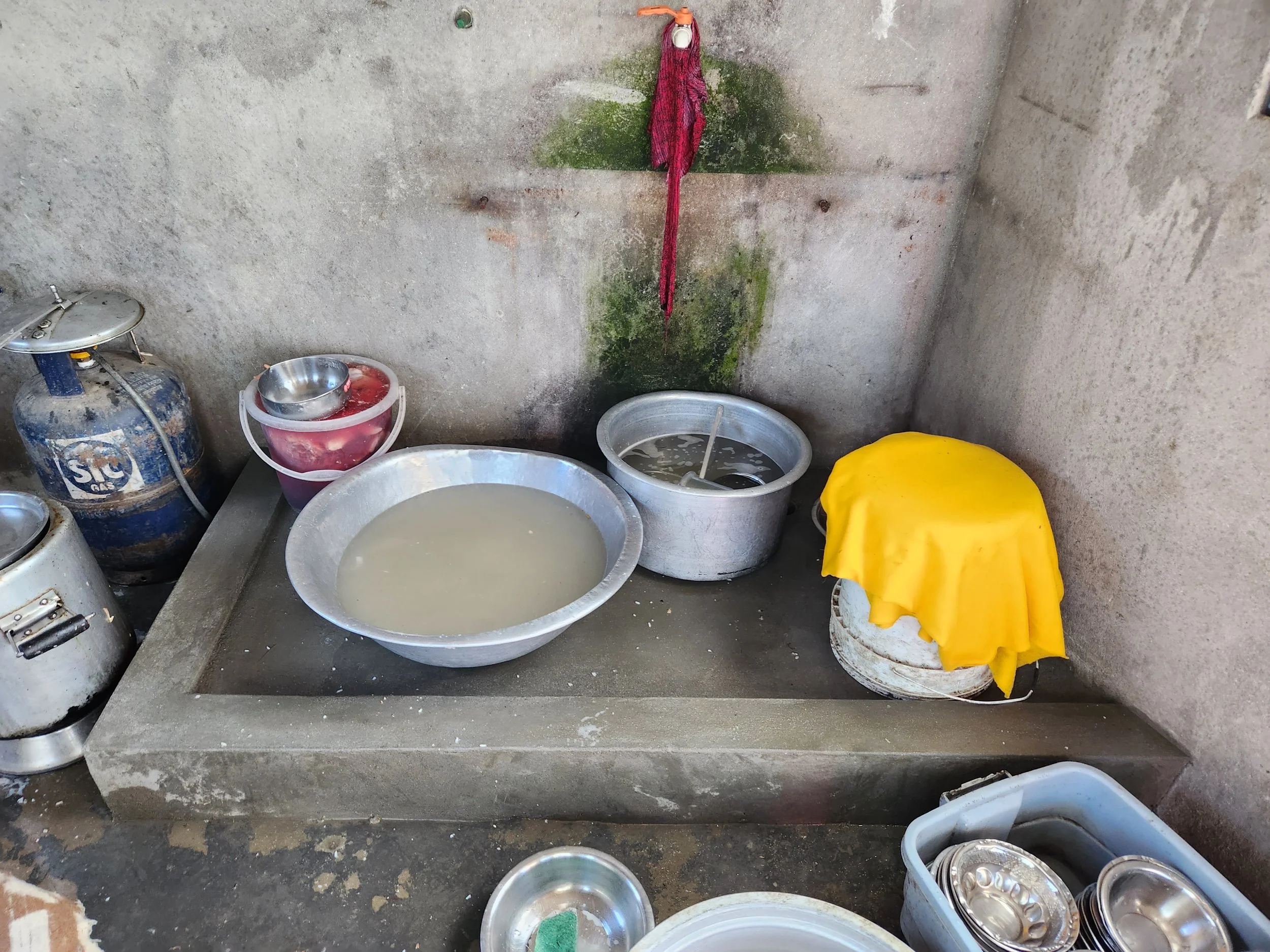Kathmandu Animal Treatment Center - helping animals on the far side of the world
A shelter’s work is never done.
Help for Kathmandu’s injured street dogs happens at Kathmandu Animal Treatment Center. Photo by Carrie Dow.
Mornings are usually intense at an animal shelter because animals who wake up hungry are loud animals. Dogs barking, cats meowing, and humans bustling about. The sounds of metal bowls clanging, gates opening and closing, the low whines of those who haven’t been fed yet. So many things need to happen – dishes need to be washed, meds need to be given, and litter boxes need to be scooped. Typical animal shelter stuff.
As a long-time shelter volunteer, I know what to expect and the shelter I’m volunteering at this week is just like any shelter in any American city, except I’m not in America. I’m 8,000 miles away in Kathmandu, Nepal, a place that is as foreign to me as Mars. However, wherever you go in the world, some things are universal, like the unconditional love of a dog or cat. Kathmandu Animal Treatment Center (KAT) knows that love well.
***
KAT Center admin building. Photo by Carrie Dow.
The KAT Center sits on the side of a hill above the Dhobi Khola River that runs down the foothills of Budhanilkantha, a municipality outside the capital of Kathmandu. Several buildings and a series of indoor/outdoor kennels make up the facility. A two-story administration building oversees the shelter and its two animal ambulance vans and small medical clinic. The shelter has 60 dog kennels and three cat houses holding up to 20 cats run by 14 staff members. There are nine Nepali board members and KAT Center USA, the shelter’s North American fundraising branch, has seven.
KAT was founded by British expat Jan Salter, an acclaimed artist who moved full time to Nepal in 1975. She was renown throughout her adopted country for her artwork and her compassion for humans and animals. Her work was famously featured in a 1996 book, Faces of Nepal, where she traveled the country painting portraits of Nepal’s over 100 ethnic groups. She also did portraits for Maiti Nepal, an award-winning organization that rescues and supports trafficked young women and girls.
Cats welcome at KAT too. Photo by Carrie Dow.
In 2004 she used her life savings to build the KAT Center, an organization modeled on modern animal welfare practices of humane treatment, vaccination, and trap/neuter/release programs. KAT is the largest animal shelter in the country and Salter’s dedication to it was recognized by Humane Society International with the Commitment and Achievement award in 2010. She passed away in 2018, but the staff and volunteers of KAT carry on her work.
***
As I walk past the kennels to begin my daily chores, the dogs watch me closely. Some bark, some don’t, but they all watch. They are a mix of mutts – brown, tan, white, black, yellow. What all have in common is that they were brought to KAT because of illness or injury. Two dogs are recovering from surgery to remove a hind leg after being hit by a car, a common incident. A third, just a puppy, also has a broken leg that will require amputation once she’s gained some weight. Others are recovering from malnutrition and illness. Peach is one of those dogs. She had been at the shelter for six years when I arrived. Originally brought in with distemper, staff didn’t think she would survive, but she made a full recovery. She was adopted out twice but returned both times (for reasons I have no idea), so they decided to make her a permanent resident. A giant fluff ball of a dog with soft tan and white fur, floppy ears, and expansive brown eyes, Peach wags her tail at everyone who walks by in hopes someone will pay attention to her. I can’t refuse her adorable face.
Dish washing station at KAT. Photo by Carrie Dow.
My first duty was to help wash all the breakfast bowls after the dogs’ morning meal of boiled chicken and rice. We did that on the outdoor patio near the “kitchen,” called that because it was where food was prepared. However, it was as bare bones as a kitchen could be. There was a freezer where meat was stored and a large cement sink built into the floor. There was a propane tank connected to a large burner for cooking rice. Clean dishes were stacked on a counter and underneath were sacks of rice. To do dishes, we sat on overturned buckets using dish water heated with the propane burner. Then we used a cold-water hose for rinsing and let the bowls dry in the sun.
Next we gave all the dogs fresh water using watering cans with long nozzles so we could fill the bowls without having to open the kennel. This was especially helpful with the distemper dogs because we needed to avoid contact and because sick dogs can be unpredictable and sometimes dangerous. After that I would do some laundry. There was no dryer at KAT so I would hang wet blankets and towels on a clothesline. (To my knowledge no one in Nepal had a clothes dryer. Even the newest of homes and businesses had clotheslines on a back porch or rooftop with clothes or linens in full view.) Then I would start the next load. No matter how many loads I put in the washer, the dirty pile next to the machine never seemed to get smaller, much like every other shelter I’ve volunteered at.
Bath time at KAT Center. Photo by Carrie Dow.
After this we would give the smaller dogs a bath. Again, we would warm up some water with the propane burner and use a large rice bowl as a tub. After a towel rub to dry, the dogs would lay on a blanket in the sun to warm up while being brushed, along with removing a few ticks, and swabbing ears clean and lots of pets and belly rubs.
We joined the staff for lunch cooked by a staff member. It was usually a traditional Nepalese meal of dal bhat (rice with lentils) sometimes topped with a spicy sauce alongside veggies like cauliflower or potatoes. It was always delicious and filling and we would chat with the staff and other volunteers about where we from and how we ended up at KAT. One volunteer was from Germany and my travel companions were from Canada. We were responsible for washing our own dishes when finished.
The afternoons were for dog walks. All were eager to go, even the two new tripods who quickly learned to navigate the steep roads on three legs, bounding so fast it was hard for me to keep up. While the dogs enjoyed their 15-20 minutes of freedom, for me it was a hot trudge up and down the steep streets of the shelter’s neighborhood on those sunny afternoons.
All KAT dogs enjoy an afternoon walk, even the tripods. Photo by Carrie Dow.
While the shelter work was typical, I noticed some cultural differences. While some of the dogs had names, others didn’t, which made it hard to communicate. A staff member said that the dogs they hope to adopt out are not given names so that potential adopters can give them their own. I mention in the States, we change the dog’s name if we don’t like the shelter name. She countered that they have had people not adopt a dog because they didn’t like the name.
The biggest cultural difference is street dogs are an accepted part of Nepalese society. They are part of the community and community cares for them. While walking around the city I would often see place mats on the front steps of stores and homes with crackers or mounds of rice set out for them. If someone sees an injured or sick dog, they contact KAT for help. Another interesting fact, like all canines, street dogs will form their own packs and the pack mentality helped KAT’s spay and neuter programs. In many cities around the world, street dogs and cats are rounded up, neutered, and then returned to their familiar neighborhoods. KAT has two vans that not only provide emergency medical attention, but will go into various neighborhoods to round up dogs for this program. Like all packs, there is a leader and when staff put the lead dog in the van, the other dogs follow without much fuss. They are brought to the shelter where they all stay in a single large kennel and a pack of eight came through the program during my week. One by one they are neutered and then after their recovery, usually a day or two, they are dewormed and vaccinated before being returned to their neighborhood. KAT has performed over 37,500 neuters and given over 55,500 vaccinations.
Lunch is served daily for both staff and volunteers at KAT. Photo by Carrie Dow.
Is it dangerous for dogs to live on the streets? Of course. They get hit by cars; they get in fights with other packs; diseases pass easily. However, that doesn’t mean they aren’t loved. The temples around the city depicted dogs in their epitaphs and imagery. I never saw anyone shoo away a dog sleeping on a step or walking past a shop. Dogs are an important part of Nepal’s landscape. KAT Center ensures those dogs live healthy lives, which also makes the community’s health better. That’s the work of an animal shelter, no matter where in the world it is.
***
My volunteer experience in Nepal wouldn’t have been possible without the expertise of Animal Experience International (AEI). This Canadian company and certified B Corp coordinates animal volunteer trips to 28 organizations on six continents. Founded by Nora Livingstone and Dr. Heather Reid, the company personally evaluates all participating organizations for animal welfare, staff treatment, and value to their communities.
AEI’s next group trip is Thailand in May 2023. Volunteers have the option of one week working with wildlife, one week working at an elephant sanctuary, or combine them for a memorable two-week journey. Use the link above for more information about AEI travel opportunities. To learn about AEI, read my 2021 interview with Nora – link here.
Can’t make it to Nepal? You can still help KAT Center with monetary donations. Visit KAT Center.org.np to make a tax-deductible contribution to help Kathmandu’s dogs and cats.
Dogs like Peach will live healthy, happy lives thanks to KAT Center. Photo by Carrie Dow.















